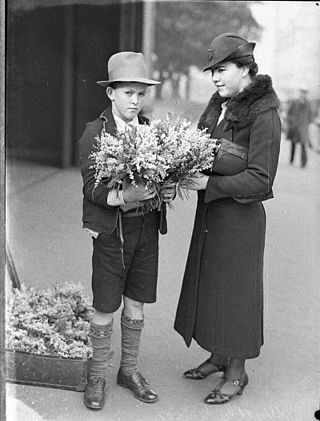
The Australian Capital Territory (ACT), known as the Federal Capital Territory (FCT) until 1938, is a federal territory of Australia. Canberra, the capital city of Australia, is located in this territory. It is located in southeastern Australian mainland as an enclave completely within the state of New South Wales. Founded after Federation as the seat of government for the new nation, the territory hosts the headquarters of all important institutions of the Australian Government.

Canberra is the capital city of Australia. Founded following the federation of the colonies of Australia as the seat of government for the new nation, it is Australia's largest inland city and the eighth-largest Australian city overall. The city is located at the northern end of the Australian Capital Territory at the northern tip of the Australian Alps, the country's highest mountain range. As of June 2022, Canberra's estimated population was 456,692.

The coat of arms of the city of Canberra was granted to the Federal Capital Commission, its successors and the City of Canberra by King George V in 1928. It has been used by the Australian Capital Territory as its de facto coat of arms, as the territory does not have one of its own. A modified version of this coat of arms also appears on the flag of the Australian Capital Territory since 1993.

Tartan Day is celebration of Scottish heritage and the cultural contributions of Scottish and Scottish-diaspora figures of history. The name refers to tartan, a patterned woollen cloth associated with Scotland. The event originated in Nova Scotia, Canada, in 1987. It spread to other communities of the Scottish diaspora and Scotland itself in the 1990s to 2000s.

Regional tartans of Canada are represented by all Canada's provinces and territories having a regional tartan, as do many other regional divisions in Canada. Tartans were first brought to Canada by Scottish settlers; the first province to adopt one officially was Nova Scotia in 1956, and the most recent province was Ontario, in 2000. Except for the tartan of Quebec, all of the provincial and territorial tartans are officially recognized and registered in the books of the Court of the Lord Lyon, King of Arms of Scotland.

The coat of arms of Victoria is the official heraldic symbol of the Australian state of Victoria. Victoria was the second state of Australia to gain arms, granted on 6 June 1910 by royal warrant of King George V. The state had been named in 1851 after his grandmother, who was in reign at the time. The final version of the arms was granted 28 March 1978 in the royal warrant issued by Queen Elizabeth II.
There are several symbols of Manitoba, one of the ten provinces of Canada. These symbols are designated by The Coat of Arms, Emblems and the Manitoba Tartan Act, which came into force on Feb 1, 1988.
Ontario is a province of Canada that has established several official emblems and symbols to reflect the province's history, natural resources, and its people. In addition to official symbols, several other emblems and symbols exist that are commonly associated with the province.

Wattle Day is a day of celebration in Australia on the first day of September each year, which is the official start of the Australian spring. This is the time when many Acacia species, are in flower. So, people wear a sprig of the flowers and leaves to celebrate the day.
New South Wales is one of Australia's states, and has established several state symbols and emblems.
The symbols of Queensland represent the Australian state of Queensland and the Queensland Government. The different symbols and emblems represent both the state and the government. The official state emblems of Queensland are prescribed in the Emblems of Queensland Act 2005.
South Australia is one of Australia's states, and has established several state symbols and emblems.
Tasmania is one of Australia's states, and has established several state symbols and emblems.
Victoria is one of Australia's states, and has established several state symbols and emblems.
Western Australia is one of the states of Australia, and has established several state symbols and emblems.

Australian heraldry is the term for the style of armorial achievements, sometimes known as coats of arms, and other heraldic bearings and insignia used in Australia. It largely follows the Gallo-British tradition of heraldry also followed in England, Scotland, Ireland, Canada and New Zealand.

District tartans for the Commonwealth of Australia and for each of its constituent States have been registered in the Scottish Register of Tartans (SRT). Additionally, fashion tartans covering either Australia as a whole, or its capital city, Canberra, have been registered in the SRT, as have district tartans in respect of some of Australia's local government areas.













